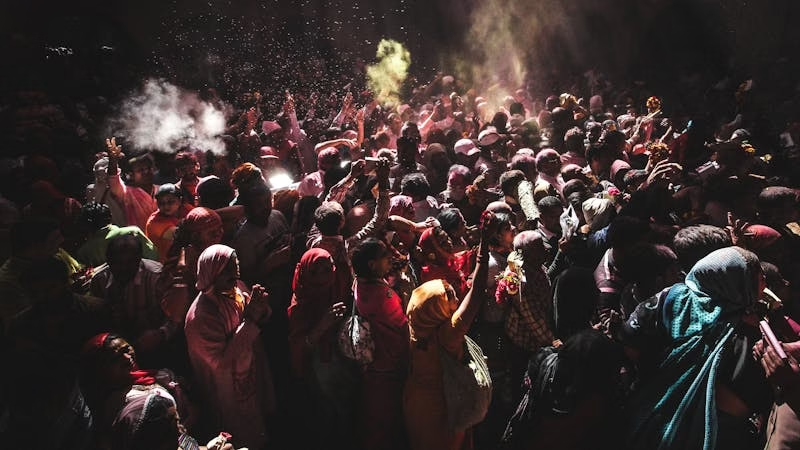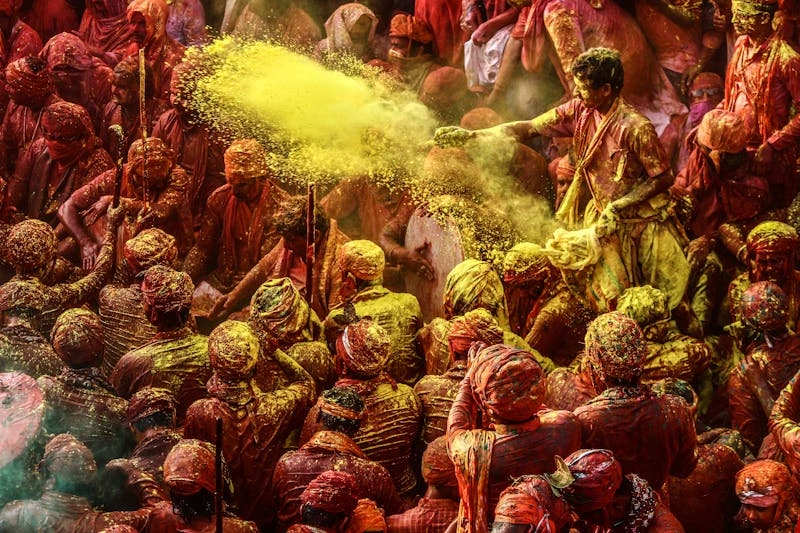📅 Quick Facts About Holi
| Aspect | Details |
|---|---|
| Festival Name | Holi |
| Also Known As | Festival of Colors, Rangwali Holi |
| Celebrated In | India, Nepal, USA, UK, and other countries |
| Significance | Victory of good over evil, arrival of spring |
| Main Rituals | Holika Dahan (Bonfire), Playing with colors |
| Famous Places | Mathura, Vrindavan, Barsana, Shantiniketan |
| Traditional Sweets | Gujiya, Malpua, Thandai |
| Bollywood Songs | Rang Barse, Balam Pichkari, Holi Ke Din |
🎭 Introduction: What is Holi?
Holi also known as the Festival of Colors, is one of the most joyful celebrations in India and around the world. The festival signifies the arrival of spring, the victory of good over evil, and a day of unity and fun.
It is celebrated with bright colors, music, dance, sweets, and water balloons. It is a time when people forget their differences and come together in love and happiness.
🏛️ The Origin & History
It has been celebrated for centuries, with mentions in ancient Hindu scriptures like the Purana and Dasakumara Charita. The festival has evolved from religious traditions to a global celebration of color and joy.
Ancient Indian texts and poets like Kalidasa have referenced Holi, highlighting its historical significance in Indian culture.
🌟 Why is Holi Celebrated?
It is celebrated for various reasons, including:
✔ Religious Significance: The triumph of good over evil as depicted in the story of Prahlad and Holika.
✔ Seasonal Change: Welcoming spring and bidding farewell to winter.
✔ Social Harmony: A time to forgive, forget, and strengthen relationships.
🎊 The Two-Day Celebration
🔥 1. Holika Dahan (The Bonfire Ritual)
On the night before Holi, people gather to light a bonfire, symbolizing the burning of evil. This tradition is inspired by the myth of Holika and Prahlad.
🌈 2. Rangwali Holi (The Festival of Colors)
The second day is full of color, water fights, and music. People smear gulal (colored powder) on each other, dance, and enjoy festive treats.

📜 Famous Legends Associated
🏹 1. Prahlad & Holika – The Victory of Good Over Evil
A key story behind Holi is about Prahlad, a devotee of Lord Vishnu, who was saved from his evil aunt Holika.
🎭 2. Krishna & Radha – The Play of Colors
Lord Krishna played Holi with Radha and the gopis, leading to the tradition of playing with colors.
🌍 Celebrations Around the World
It is not just an Indian festival; it is celebrated globally in:
🇺🇸 USA – New York, California, and Florida host Holi festivals.
🇬🇧 UK – London’s Holi Festival of Colors is a massive event.
🇳🇵 Nepal – Holi is a national festival here.
🍃 Eco-Friendly – A Sustainable Celebration
✅ Use natural colors made from flowers and herbs.
✅ Avoid plastic water balloons.
✅ Play dry Holi to save water.
⚠️ Safety Tips for a Happy Holi
✔ Apply oil on your skin and hair to prevent damage.
✔ Wear sunglasses to protect your eyes.
✔ Use organic colors to avoid skin allergies.
🏆 Best Places to Celebrate Holi in India
📍 Mathura & Vrindavan – The birthplace of Krishna, famous for Lathmar Holi.
📍 Barsana – Women playfully hit men with sticks.
📍 Shantiniketan – Rabindranath Tagore’s cultural Holi celebration.
❓ FAQ – Your Questions Answered
1. Why do we celebrate Holi?
To celebrate the arrival of spring and the victory of good over evil.
2. What are traditional Holi sweets?
Gujiya, Malpua, and Thandai.
3. Can Holi be celebrated without water?
Yes, dry Holi with organic colors is an eco-friendly alternative.
🎭 Conclusion – The True Spirit of Holi
Holi is more than just a festival; it’s a celebration of love, joy, and unity. Whether you play with colors, dance to Bollywood songs, or enjoy traditional sweets, Holi brings happiness to all.
So, this Holi, spread love, laugh, and celebrate with vibrant colors! 🌸🎨
